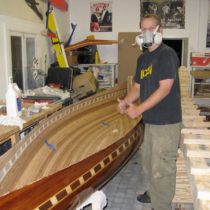Landscape Architecture for Landscape Architects › Forums › SUSTAINABILITY & DESIGN › Planning Sustainable Neighborhoods and Cities: Bringing Theory into Practice
- This topic has 1 reply, 7 voices, and was last updated 15 years, 1 month ago by
 Rico Flor.
Rico Flor.
-
AuthorPosts
-
September 28, 2008 at 11:06 pm #176465
 Jay EverettParticipant
Jay EverettParticipantWhat are some of the major economic, social, and planning issues that we face today that prevent us from having the neighborhoods and cities that we desire?
Why do we continue to repeat the mistakes of yesterday?
I will offer up some opinions to get the conversation started:
I believe that two major economic factors contribute to many of the daily frustrations we have as designers and planning professionals:
-The low market value of land on the periphery of cities – which attracts development and contributes to sprawl
and
-The price of gasoline – which enables our preferred form of transportation: the automobile and allows individuals to get to these far-flung places quickly and cheaply.Until we find a way to address these two realities I do not think we be able to produce the political will to pull federal funding away from new highway construction and return to transit oriented development which results in dense, walkable, more sustainable communities and preserves vast areas of open space for agriculture, habitat conservation, and recreation.
Can this be solved with additional regulations, tax incentives, government subsidies, land trusts, urban growth boundaries and grass roots initiatives (which have all been tried with limited success) or are we doomed to wait until global oil production peaks and raises the costs of fuel astronomically? Will it be too late?
September 29, 2008 at 1:33 pm #176474 Rico FlorParticipant
Rico FlorParticipantHi Jay.
Might be simplistic but, I’ll call it the way I saw it: it’s not always in the client’s best interest to planning and design theories we see as win-win. For example, trees to reduce solar exposure and reduce energy inputs get sidelined because it covers the desired architecture. Besides, it forces people quickly out of the cars and into shopping malls. Transit links that increase site permeability gets vetoed because it courses people quickly through and away retail shops; they opt to cut short the links to practically spill people onto the retail area even if it becomes more difficult for the pedestrian.
At this point, before my pessimism overwhelms me, I suggest we get to see and discuss more of successful examples. Eeeks! Bad day at the office? Seeking everyone’s pardon, and
Cheers!
Rico
September 29, 2008 at 5:38 pm #176473 Jay EverettParticipant
Jay EverettParticipantThanks for your response Rico, I think you’re right it is important to stay positive when facing our frustrations with certain policies that guide development. It’s also good to hear that Americans designers aren’t the only ones who sometimes feel forced to compromise good design for perceived economic benefits.
I think we need to start arming ourselves with data that supports good design so we can make successful rebuttals.
Is anyone seeing real, measurable success for sustainability at the city and regional level in their area? Can anyone make the argument that “good” development (pedestrian/transit oriented) in their area is out pacing “bad” development (automobile dependant/ sub-urban sprawl).
September 30, 2008 at 5:03 am #176472 Jay EverettParticipant
Jay EverettParticipantI like the conversation that is going here, everyone’s making some pretty good points…
We have all heard that the U.S. economy is heavily dependent on oil which is considered a non-renewable resource, but what does that actually mean? It means in 2007 Petroleum accounted for almost 40% of our total Primary Energy Consumption.
Of that amount about 70% of petroleum was used for transportation (e.g. gasoline, diesel, jet fuel), 24% by industry (e.g. production of plastics), 5% for residential and commercial uses, and 2% for electricity production.

sourceOur automotive industry and infrastructure is particularly dependent upon oil. No only fuel, but lubricants, belts, wire insulation, and plastics go into the manufacturing of automobiles. Asphalt roadways, parking lots, and the tires we use are all petroleum products.
nrshmid has a point, Americans are driving less, and more are choosing to use transit in 2008, but only a little.
However, I do not think this is a sign that our society is ready to adapt to the significant lifestyle changes that are probably necessary in order to reduce our consumption, the current system is not sustainable.

sourceThe market will bring consumers around eventually, after peak oil production is reached. The ensuing market forces will force people to live closer to work, grow food and produce some products closer to the markets they are intended for. There will be lots of people looking for transit oriented communities but there may not be very many around because right now they have high initial investment costs.
Transit systems (and I mainly mean rail-based transit) do not pay for themselves unless ridership is high. In order for ridership to be high you have to have a lot of people in proximity to the system. In general, 5 to 10 dwelling units per acre gets people riding transit, and it optimizes somewhere around 30 to 50 units per acre, but driving continues to decrease as density increases.

sourceUnlike sprawl, this type of dense, walkable, transit oriented development cannot spring up over night. Before the automobile, it occurred naturally. Today it takes a considerable amount of planning, design, permitting, and financing to construct neighborhoods and cities like this.
To clarify my position on federal Highway funding, I think we need to continue to maintain existing infrastructure but limit new construction and highway capacity increases so that we can limit induced traffic. Instead give priority to Regional and local Mass Transit projects that can be used to foster transit oriented development.
So back to the main topic, there is plenty of evidence that suggests the wise decision for our society (mainly Americans) to make is to deliberately make a dramatic shift towards “Smart Growth” , “Transit-Oriented-Development”, “Walkable Communities” and “New Urbanism.”
Is anyone seeing this really happen?
What we are doing on a daily basis, is it really urbanism or are we just moving toward a “new suburbanism?”April 22, 2009 at 6:43 pm #176471 Sarah McCandlissParticipant
Sarah McCandlissParticipantHi Jay, this doesn’t exactly speak to your point but I think it is a related issue: unsustainable communities and how to manage them. I’d be interested to hear others’ thoughts on this idea for dealing with Michigan’s economic crash.
I was pretty shocked by this article in today’s (4/22/09 Earth Day!) New York Times: An Effort to Save Flint, Michigan By Shrinking It
http://www.nytimes.com/2009/04/22/business/22flint.html?_r=1&th&emc=th
It made me think of
-the community redevelopment bulldozing of the Victorians in the Western Addition of San Francisco in the 1960’s and how it was preceived to be a horrible thing by the late 70’s – just a few years later;
-The wastefulness of bulldozing homes in the face of homelessness in the US and abroad
-The loss of community and material history
-The social impact of determining what/who stays and what/who goes – potential for political gerymandering of a sort – who is wise enough to make these decisions?
-The wastefullness of the resources/materials that make a house and neighborhood: wood, glass, concrete…could it be recycled/repurposed?
-Excitement about the idea of returning broad swaths of urban land to its native condition – what a project!!
– Are there precedents for dismanteling a community in this way?
-Who will pay?
Thanks,
SarahApril 28, 2009 at 6:27 am #176470Doug Prouty
ParticipantJay you have some nice data and this is an on-giong dicussion at our firm. As a land planning and lanscape architecture firm in Arizona, we are faced with urban sprawl and intense peripheral development on a daily basis, though it is a bit slow now with the economy being as it is…. With the majority of the national home building companies being a publicly traded company and subject to the demands of their investors, profits need to be reached. In order to reach a profit, the land must have a low cost, the housing fabrication price must be low, the design fees resonable and the house prices must be favorable. Mix in this that most national builders have a financing arm that can help homeowners buy a home and with the rates being low, now is the time to buy. Once the existing new home inventory and the foreclosures have been burned off and the market is more stable, development will pick up as usual unitl something happens that will make people think again about driving distances and how the price of gas dents the wallet. This is a basic that we all know, so no need to go any further.
In Arizona, we are well known for sprawl and development of greenfields. In-fill projects haven’t taken off very well due to the high cost of land. With the low cost of homes and gas being at $1.65 – $1.90, people will be looking for homes on the edge of town and will not bother with in fill projects, until again gas prices are hiked up. The cost of buying an in-fill homesite here is still pretty high, around $300-$400k for a 1800-2400 sf home, while a home on the edge of town (which can be about 40-50 miles away from downtown Phoenix) is now priced at $75-$85k for a similar sized home. Economically it makes sense to drive more and buy a same sized home at a lower price.
One way to curb this repeating trend is to have gas at a price where people will think twice about what is affordable and what isn’t. If gas was at $2.75 tp $3,50 people will again look at where they live and prioritize better for future expendatures… or so we hope.
Hope may be in the form of light rail, but it just arrived here in Phoenix and it hasn’t been built where it is needed the most, on the outter edge of development. Our current light rail system covers a limited area within the 4-5 cities that it services. Unlike Denver where the light rail is reaching to the more outer suburbs, we have a long road ahead and it will take time before we can get enough public funds and interest to build more lines.
So how are we designing to accomodate our current urban sprawl? When desiging large masterplan communities such as our Belmont project, the goal is to create a city within itself that can attract residents that will become the local work force. Provide educational facilities, industrial R&D and tech campuses, retail/ commercial, outdoor regional parks, walk-able neighborhoods, a comprehensive community trail system, a thoughtfull transit system within and around the development and other amenities that encourage internal development. Is this a designers dream? Sure it is, but it’ll happen as it has been done with other projects of similar size. With 25,000 acres to develop, it will take 20-30 years to fully realize a project of this size and if other design firms that develop within the Belmont development grasp the concepts that we have laid down before them we will have a succesfull sustainable project but only time will tell.
May 16, 2009 at 12:47 am #176469 Jay EverettParticipant
Jay EverettParticipantDoug,
From my point of view it seems to come back to economics and homebuyer/renter’s choices as it relates to lifestyle preference. I’ve observed that when you put the kind of thought and design into a new greenfield development like the one that you describe above, it is almost always impossible to control property values. I feel that scarcity is driving this to some extent.When there aren’t many existing choices in a region of well designed places where people can live close to employment and shopping, those who can afford it, tend to flock to the few areas where this is possible. The lack of supply of these living situations drives up the home values and before long even the units and homes designated as “affordable housing” are well above the means of the average citizen.
For a long time the choice the american homebuyer and even renters to a certain extent, have been faced with has been “How far am I willing to drive for value?”
or in an infill situation…
“How much crime or the threat of crime (real or imagined) am I willing to tolerate for value?”
There are even generational preferences when it comes to this question, and there are measurable trends that give me a reason to hope.
Maybe today’s younger generations are finally catching on to what’s been happening, and will make the the market decisions en masse that will be required to turn the tide and not only stop sprawl but perhaps even send it back in the other direction.
June 5, 2009 at 7:26 pm #176468 Bob LutherParticipant
Bob LutherParticipantThere is also one point that everyone seems to be missing, and that is the “American Dream”. if you live on the east coast the idea of living in a brownstone and moving to a Penthouse is a plausible dream (staying within the framwork of high density), but most people opt to head to the suburb, across the bridge, into an area that they can have to 2.5 kids, a cat, a dog, and a white picket fence. On the West coast, other than Seattle, San Francisco, San Diego and Portland, most people are looking outward to fulfil there dreams becaus they already linve in the suburbs, or the city (LA in particular) is far from attractive. the midwest has a few urban centers, but how do you get people in rural Iowa or Kansas to live close together or on top of one another when there is so much land, the younger generation is moving into the urban areas for work but those who live in the farming towns are not going to change there views of how to live just because people think there is a better way. How much does it cost to build a skyscrapper vs. how much does it cost to build a track of homes? until you convince the people that you way of development is better and more desirable, they will stick to the path that they have always had in their dreams.
June 17, 2009 at 2:22 pm #176467 Ben YahrParticipant
Ben YahrParticipantThe “American Dream” is becoming less realistic financially and functionally. If we can invest in amenities, parkland, vibrant architecture, functional/appealing mass transit, and encourage business development- urban living will become much more appealing than the suburbs.
Growing up in a “bedroom community” (even worse than a suburb!) we drove to the “city” every chance we could. The city has entertainment, shopping, and for most people work. The amount of time spent driving was ridiculous. That was when gas was cheap.
If there is affordable, appealing(secure, private, spacious, variety of entertainment options, etc) housing in urban areas why would anyone choose the suburbs? Now is that possible..?
June 17, 2009 at 7:16 pm #176466 Roland BeinertParticipant
Roland BeinertParticipantJust wanted to post this link: http://www.treehugger.com/files/2009/06/us-smart-growth-sustainable-agenda.php
-
AuthorPosts
- You must be logged in to reply to this topic.


